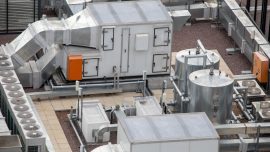
The Importance of Good Ventilation In Hospitals After the Covid-19 Pandemic
The numbers of COVID-19 positive cases rise and fall with little to no warning.
From staff to medically vulnerable patients, hospitals require excellent ventilation to decrease the spread of COVID-19. Below, we’ll discuss the importance of good ventilation concerning the COVID-19 pandemic.
Why Good Ventilation Matters in Hospitals
The COVID-19 pandemic taught us (and continues to teach us) that ventilation is a crucial aspect that decreases the spread of a virus.
COVID-19 is easily spread in unventilated indoor spaces because it can be spread via infected droplets or aerosols. In other words, simply speaking without a mask produces microscopic droplets that can infect a nearby individual.
Hospitals are prime locations to spread viruses and bacteria because they are where sick individuals go for care. Thus, hospitals must upgrade their ventilation systems to ensure airborne illnesses, such as COVID-19, do not easily spread within the premises.
How Increased Ventilation Decreases the Spread of COVID-19
The most rudimentary form of increasing ventilation is to open a window.
Although this may work for a residential home — it won’t work for a large hospital complex. Hospitals require commercial-grade HVAC systems to ensure proper temperatures and optimized airflow.
Since COVID-19 is spread through infected droplets and aerosols, constant air exchange is necessary to decrease the number of infections within a hospital.
Since the concentration of infected individuals is high in a hospital, it’s clear that hospitals require specific HVAC systems that can handle a high level of air exchange per minute.
The Benefits of Good Ventilation in Hospitals
Below, we’ll briefly discuss the primary benefits of optimized ventilation in Canadian hospitals.
Reduce the Risk of Infection
The main consideration of installing optimized HVAC systems within a hospital is to reduce the risk of infection.
Even if a nurse is dealing with an infected patient — the risk is lower when both individuals utilize masks in conjunction with good ventilation. Even if infected droplets make it through the mask, the droplets are evacuated via an effective ventilation system.
COVID-19 and other infectious diseases run the risk of severe illness or death — which is why hospitals must upgrade their ventilation system.
Minimize the Number of Sick Days
Good ventilation reduces the number of sick staff — thus decreasing the shortage of hospital staff seen during the early days of the COVID-19 pandemic.
During the first year of COVID, hospitals in Canada and worldwide were slammed with staff calling in sick. Considering COVID-19 was quickly spreading within hospitals, it only made sense that many staff members fell ill.
Thus, optimized ventilation systems are vital to reducing the number of sick days taken by staff members.
Being Prepared For the Future
Lastly, good ventilation should be the standard after dealing with the repercussions of COVID-19.
The Coronavirus taught us that infectious viruses could spread with terrifying speed. Simple yet effective technologies like efficient HVAC systems are the key to minimizing the spread of viruses indoors.
While we continue to deal with COVID-19 — the possibility of other infectious diseases is on the horizon. From Monkeypox to the common flu, hospitals must prepare for the future by installing medical-grade HVAC systems to maintain the safety of staff and patients in Canada.
Take Hospital Ventilation to the Next Level
If your hospital is ready to upgrade its ventilation to protect staff and patients from the spread of airborne illnesses — M&T Air Conditioning is prepared to get the job done.
From professional installation to medical-grade HVAC systems, M&T Air Conditioning offers everything your business needs to maintain the best ventilation year-round.







